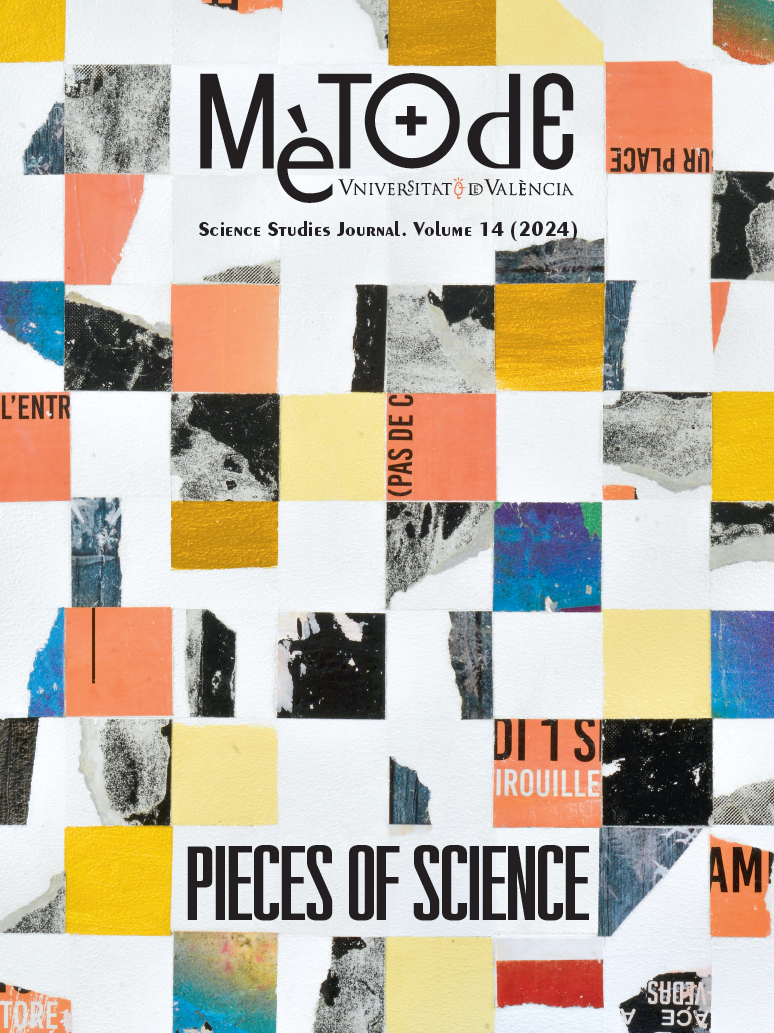A picture and a thousand words: The pairing of photography and science
DOI:
https://doi.org/10.7203/metode.14.25534Keywords:
photography, science, scientific photography, history, conservation Abstract
Abstract
Photography was born at the beginning of the 19th century as a tool for representing the world around us. With its advent, the scientific community found an ally to push back the frontiers of knowledge. Since then, the pairing of photography and science has evolved considerably. Photography has positioned itself not only as an effective means of collecting data, but also as a tool for sharing scientific information, both inside and outside the academic world. In addition, technological developments in recent decades have encouraged almost constant interaction between photography and the public, including the research community. This has further opened up possibilities for integrating photography into scientific career development.
 Downloads
Downloads
 References
References
Baadte, C., & Meinhardt-Injac, B. (2019). The picture superiority effect in associative memory: A developmental study. British Journal of Developmental Psychology, 37(3), 382–395. https://doi.org/10.1111/bjdp.12280
Bálint, A., Andics, A., Gácsi, M., Gábor, A., Czeibert, K., Luce, C. M., Miklósi, Á., & Kröger, R. H. (2020). Dogs can sense weak thermal radiation. Scientific Reports, 10(1), 3736. https://doi.org/10.1038/s41598-020-60439-y
Barger, M. S., & White, W. B. (2000). The daguerreotype: Nineteenth-century technology and modern science. JHU Press.
Battiston, P., Sacco, P. L., & Stanca, L. (2022). Cover effects on citations uncovered: Evidence from nature. Journal of Informetrics, 16(2), 101293. https://doi.org/10.1016/j.joi.2022.101293
Buriak, J. M. (2015). How we choose cover images. Chemistry of Materials, 27(16), 5451–5452. https://doi.org/10.1021/acs.chemmater.5b03094
Costa, A., & Salvidio, S. (2021). Animal behaviour on the cover: Layout cover patterns of ethological journals. Ethology Ecology & Evolution, 33(2), 191–199. https://doi.org/10.1080/03949370.2020.1845809
Darwin, C. (1845/2001). The voyage of the Beagle: Journal of researches into the natural history and geology of the countries visited during the voyage of H. M. S. Beagle round the world. The Modern Library.
Defeyter, M. A., Russo, R., & McPartlin, P. L. (2009). The picture superiority effect in recognition memory: A developmental study using the response signal procedure. Cognitive Development, 24(3), 265–273. https://doi.org/10.1016/j.cogdev.2009.05.002
Gaucherd, H. (1839, 12 January). The Daguerreotype. Literary Gazette, and Journal of the Belles Lettres, Arts, Sciences, & C., 1147, 28.
Kong, L., & Wang, D. (2020). Comparison of citations and attention of cover and non-cover papers. Journal of Informetrics, 14(4), 101095. https://doi.org/10.1016/j.joi.2020.101095
Snow, C. P. (1959). The two cultures and the scientific revolution. Cambridge University Press.
Wang, G., Gregory, J., Cheng, X., & Yao, Y. (2017). Cover stories: An emerging aesthetic of prestige science. Public Understanding of Science, 26(8), 925–936. https://doi.org/10.1177/09636625177066
Wang, Y., Xie, Y., Wang, D., Guo, L., & Zhou, R. (2022). Do cover papers get better citations and usage counts? An analysis of 42 journals in cell biology. Scientometrics, 127(7), 3793–3813. https://doi.org/10.1007/s11192-022-04444-0
Ward, M., Carwardine, J., Watson, J. E., Pintor, A., Stuart, S., Possingham, H. P., Rhodes, J. R., Carey, A. R., Auerbach, N., Reside, A., Yong, C. J., & Tulloch, A. I. (2022). How to prioritize species recovery after a megafire. Conservation Biology, 36(5), e13936. https://doi.org/10.1111/cobi.13936
Wilder, K. E. (2009). Photography and the art of science. Visual Studies, 24(2), 163–168. https://doi.org/10.1080/14725860903106161
Downloads
Published
How to Cite
-
Abstract1303
-
PDF201
Issue
Section
License
Copyright (c) 2023 CC BY-NC-ND 4.0

This work is licensed under a Creative Commons Attribution-NonCommercial-NoDerivatives 4.0 International License.
![]()
All the documents in the OJS platform are open access and property of their respective authors.
Authors publishing in the journal agree to the following terms:
- Authors keep the rights and guarantee Metode Science Studies Journal the right to be the first publication of the document, licensed under a Creative Commons Attribution-NonCommercial-NoDerivatives 4.0 International License that allows others to share the work with an acknowledgement of authorship and publication in the journal.
- Authors are allowed and encouraged to spread their work through electronic means using personal or institutional websites (institutional open archives, personal websites or professional and academic networks profiles) once the text has been published.





